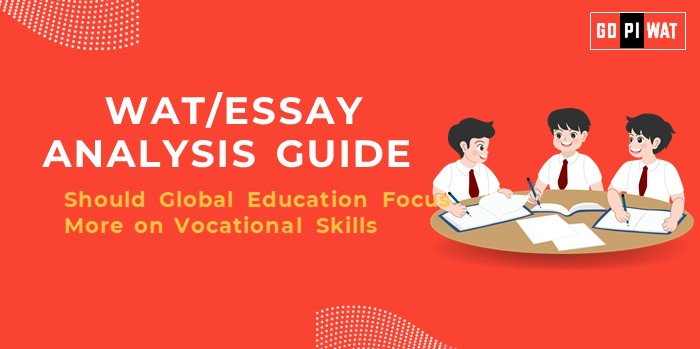📋 Should Global Education Focus More on Vocational Skills?
🌐 Written Ability Test (WAT) / Essay Analysis Guide
🔎 Understanding the Topic’s Importance
Vocational education equips students with practical, job-ready skills crucial in today’s dynamic global economy. With rising youth unemployment and widening skills gaps, integrating vocational skills into education systems worldwide can address economic challenges and boost employment opportunities.
📝 Effective Planning and Writing
- ⏳ Time Allocation:
– Planning: 5 minutes
– Writing: 20 minutes
– Reviewing: 5 minutes - 🔍 Preparation Tips:
– Research global statistics and case studies.
– Identify successful vocational systems (e.g., Germany, Singapore).
– Outline arguments that balance theoretical and practical education.
✍️ Introduction Techniques for Essays
- 🎭 Contrast Approach:
“While higher education equips students with knowledge, vocational training bridges the critical gap between learning and employment, addressing workforce challenges.” - 💡 Solution-Based Approach:
“To tackle global youth unemployment and align education with market demands, prioritizing skill-based vocational education is not just necessary but inevitable.”
📚 Structuring the Essay Body
🏆 Achievements
- 🇩🇪 Germany’s Dual Education System: Combines classroom learning with on-the-job training, boasting youth unemployment rates as low as 5%.
- 🇮🇳 Skill India Initiative: Trained over 20 million individuals, enhancing job readiness for diverse industries.
- 🔧 Practical Outcomes: Vocational education produces skilled workers aligned with industry needs, driving economic growth.
⚠️ Challenges with Comparative Analysis
- 🏛️ Perception Biases: Vocational skills are often viewed as inferior to academic education, particularly in developing nations.
- 💰 Lack of Funding: Vocational education programs require significant infrastructure and investment for success.
- 🌍 Global Inequality: While nations like Singapore excel in vocational training, many developing countries face implementation hurdles due to limited resources.
🚀 Future Outlook
- 🎓 Integrating Vocational Skills: Blend vocational training with traditional education systems to provide holistic development.
- 🌐 Lifelong Learning: Promote upskilling and reskilling programs to ensure workforce adaptability in a rapidly evolving job market.
- 🤝 Public-Private Partnerships: Collaborate with industries to fund and implement vocational training initiatives, bridging the skills gap.
💡 Concluding Effectively
- ⚖️ Balanced Perspective:
“Blending vocational skills with academic education ensures holistic development, empowering individuals with both theoretical knowledge and practical expertise.” - 🌍 Global Comparison:
“Drawing from models like Germany’s dual education system and Singapore’s skills-based approach, global education can evolve to meet the demands of 21st-century economies.”
🔍 Recommendations for Sustainable Progress
- 🏫 Curriculum Integration: Embed vocational training into mainstream education from secondary school levels.
- 📈 Investment in Infrastructure: Prioritize funding for vocational schools and teacher training.
- 🌐 International Collaboration: Partner with successful global models to adapt vocational best practices locally.
📝 Sample Short Essays
⚖️ Balanced Perspective:
“Vocational training provides students with essential practical skills to meet workforce demands. However, its success depends on balancing theoretical education with hands-on learning to create adaptable, future-ready individuals.”
💡 Solution-Oriented:
“To bridge the global skills gap, education systems must prioritize vocational skills alongside traditional subjects. Public-private partnerships and government support can ensure widespread implementation, boosting employability.”
🌍 Global Comparison:
“Germany’s dual education system and Singapore’s focus on skill-based curricula prove that vocational education can drive economic growth and innovation. By adopting similar models, global education can equip students with job-ready skills for modern industries.”


